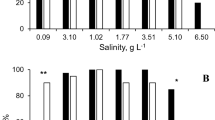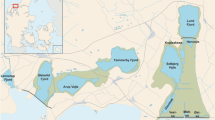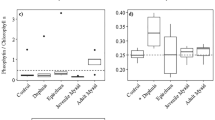Summary
Daphnia hyalina and Daphnia cucullata were kept in flow-through chambers in lake water (I), water from mass cultures of D. hyalina (II) and water from mass cultures of D. cucullata (III). A good correlation between body length and clutch size of the Daphnia was found in all cases. The regression lines of the different treatments were compared with respect to different slopes and different intercepts. D. hyalina showed the same reaction to medium II and III, but a lower regression coefficient and higher intercept in medium I. In contrast D. cucullata showed the same reaction to medium I and II, but a higher regression coefficient in medium III.
Similar content being viewed by others
References
Bengtsson G (1982) Energetic costs of amino acids exudation in the interaction between the predator Gammarus pulex L. and the prey Asellus aquaticus L. J Chem Ecol 8:1271–1281
de Beauchamp P (1952) Un facteur de la variabilite chez les rotiferes du genre Brachionus. C R Acad Sci (Paris) 234:573–575
DeMott WR (1983) Seasonal succession in a natural Daphnia assemblage. Ecological Monographs 53:321–340
Frank PW (1952) A laboratory study of intraspecies and interspecies competition in Daphnia pulicaria (Forbes) and Simocephalus vetulus O.F. Müller. Physiol Zool 25:178–204
Gardner WS, Miller III WH (1981) Intracellular composition and net release rates of free amino acids in Daphnia magna. Can J Fish Aquat Sci 38:157–162
Gilbert JJ (1967) Asplanchna and postero-lateral spine production in Brachionus calyciflorus. Arch Hydrobiol 64:1–62
Gocke K (1970) Untersuchungen über Abgabe und Aufnahme von Aminosäuren und Polypeptiden durch Planktonorganismen. Arch Hydrobiol 67:285–367
Grant JWG, Bayly IAE (1981) Predator induction of crests in morphs of the Daphnia carinata King complex. Limnol Oceanogr 26:201–218
Halbach U (1969) Die Zusammenwirken von Konkurrenz und Räuber-Beute-Beziehungen bei Rädertieren. Zool Anz (Suppl) 33:72–79
Halbach U (1970) Die Ursachen der Temporalvariation von Brachionus calyciflorus Pallas (Rotatoria). Oecologia (Berlin) 4:262–318
Halbach U (1973) Quantitative Untersuchungen zur Assoziation von planktischen Rotatorien in Teichen. Arch Hydrobiol 71:233–254
Hall DJ, Cooper WE, Werner EE (1970) An experimental approach to the production dynamics and structure of freshwater animal communities. Limnol Oceanogr 15:839–928
Hall DJ, Threlkeld ST (1976) The size-efficiency hypothesis and the size structure of zooplankton communities. Ann Rev Ecol Syst 7:177–208
Hofmann W (1979) Characteristics of syntopic populations of Eudiaptomus gracilis (Sars) and E. graciloides (Lilljeborg) in three lakes of different trophic levels. Arch Hydrobiol 86:1–12
Jacobs J (1977a) Coexistence of similar zooplankton species by differential adaptation to reproduction and escape, in an environment with fluctuating food and enemy densities. I. A model. Oecologia (Berlin) 29:233–247
Jacobs J (1977b) Coexistence of similar zooplankton species by differential adaptation to reproduction and escape, in an environment with fluctuating food and enemy densities. II. Field data analysis of Daphnia. Oecologia (Berlin) 30:313–329
Jacobs J (1978) Coexistence of similar zooplankton species by differential adaptation to reproduction and escape, in an environment with fluctuating food and enemy densities. III. Laboratory experiments. Oecologia (Berlin) 35:35–54
Janicki A, De Costa J (1979) A multivariate analysis of the crustacean plankton community of an acid reservoir. Arch Hydrobiol 85:465–481
Katona SK (1973) Evidence for sex pheromones in planktonic copepods. Limnol Oceanogr 18:574–583
Krueger DA, Dodson SI (1981) Embryological induction and predation ecology in Daphnia pulex. Limnol Oceanogr 26:219–223
Lampert W (1978) Release of dissolved organic carbon by grazing zooplankton. Limnol Oceanogr 23:831–834
Lampert W (1981) Inhibitory and toxic effects of blue-green algae on Daphnia. Int Rev Ges Hydrobiol 66:285–298
Lampert W (1982) Further studies on the inhibitory effect of the toxic blue-green Microcystis aeruginosa on the filtering rate of zooplankton. Arch Hydrobiol 95:207–220
Luecke C, O'Brien WJ (1983) The effect of Heterocope predation on zooplankton communities in arctic ponds. Limnol Oceanogr 28:367–377
Parker RA (1960) Competition between Simocephalus vetulus and Cyclops viridis. Limnol Oceanogr 5:180–189
Seitz A (1980) The coexistence of three species of Daphnia in the Klostersee. I. Field studies on the dynamics of reproduction. Oecologia (Berlin) 45:117–130
Author information
Authors and Affiliations
Rights and permissions
About this article
Cite this article
Seitz, A. Are there allelopathic interactions in zooplankton? Laboratory experiments with Daphnia . Oecologia 62, 94–96 (1984). https://doi.org/10.1007/BF00377380
Received:
Issue Date:
DOI: https://doi.org/10.1007/BF00377380




